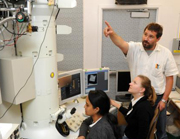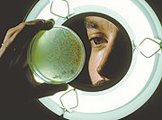


Since all of the action of breaking down lignin and other plant constituents to fermentable sugars will take place in the cell walls of second-generation biofuel feedstocks, it is probably a good idea to know the exact make-up of a cell wall. That complex challenge is being accepted by electron microscopist Manfred Auer (above right) and his team of imaging specialists at Berkeley Lab and UC Berkeley. "We need a realistic model of a cell wall to understand the 'building principles' that nature has come up with," said Auer. More>
 [earth2tech] Anecdotally we knew it was true: Digital music downloaded to our computers eliminates all that energy required to produce and ship CDs. But a group of researchers from Carnegie Mellon University, Berkeley Lab and Stanford University, including longtime IT energy researcher Jonathan Koomey, have concluded that, in general, buying digital music reduces the energy and carbon emissions of delivering the music by between 40 and 80 percent compared with traditional CD distribution methods. More>
[earth2tech] Anecdotally we knew it was true: Digital music downloaded to our computers eliminates all that energy required to produce and ship CDs. But a group of researchers from Carnegie Mellon University, Berkeley Lab and Stanford University, including longtime IT energy researcher Jonathan Koomey, have concluded that, in general, buying digital music reduces the energy and carbon emissions of delivering the music by between 40 and 80 percent compared with traditional CD distribution methods. More>
The Lab's x-ray awareness training (EHS 475) informs employees of the health and safety risks associated with the operation and use of intentional x-ray emitters, such as diffraction, fluorescence, and irradiator machines. This introductory course is mandatory prior to commencing work with x-ray machines authorized by an X-Ray Authorization (XA). Other radiation protection courses may also be required and will be specified in the XA covering the work. Go here to access the web-based training. Contact James Basore (x7524) for more information.
 World of Science: Deployment of Key Technologies in Next Decade Key to Energy Future, says Report
World of Science: Deployment of Key Technologies in Next Decade Key to Energy Future, says Report With a sustained national commitment, the United States could obtain substantial energy-efficiency improvements, new sources of energy, and reductions in greenhouse gas emissions through the accelerated deployment of existing and emerging energy technologies, according to "America's Energy Future: Technology and Transformation," a report by the America's Energy Future project, which is sponsored in part by the Department of Energy. More>
Today at Berkeley Lab is produced by Public Affairs' Communications Department